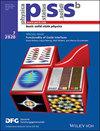超宽带隙氧化镓薄膜中自阱的非辐射特性
IF 1.8
4区 物理与天体物理
Q3 PHYSICS, CONDENSED MATTER
引用次数: 0
摘要
超宽带隙β-Ga2O3 中自阱空穴(STH)的光致发光(PL)通常是其最主要的光发射,也是其固有的特性。因此,了解影响聚光特性的晶体动力学对传感器和其他技术至关重要。我们在 77-622 K 的极端温度范围内对聚光、拉曼-声子及其相互作用进行了研究。研究发现,高能拉曼模式是通过激活能为 72 meV 的 STH-声子相互作用实现非辐射聚光过程的主要途径。在强声子耦合极限下,这种动态可通过构型坐标方案进行建模。异常宽广的高斯PL线宽体现了这种耦合。PL 能量峰位置的微弱温度响应表明,STH 具有深层缺陷的特征。这与通过透射确定的薄膜光隙的大红移(≈220 meV)形成鲜明对比。与高能声子的温度响应不同,低能声子的行为是随着玻色-爱因斯坦种群的增加而变化的,这表明它与 STH 没有强烈的相互作用。本文章由计算机程序翻译,如有差异,请以英文原文为准。
The Nonradiative Properties of Self‐Trapped Holes in Ultra‐Wide Bandgap Gallium Oxide Film
The photoluminescence (PL) of self‐trapped holes (STH) in ultra‐wide bandgap β‐Ga2 O3 is commonly its most dominant light emission and is an inherent property. Thus, gaining knowledge of the crystal dynamics that impact the PL properties is vital to sensor and other technologies. The PL, Raman‐phonons, and their interactions are studied at an extreme temperature range of 77–622 K. The PL is studied up to the bandgap value of ≈5 eV. It is found that the high‐energy Raman modes provide a major route to the nonradiative process of the PL via STH–phonon interaction with an activation energy of 72 meV. This dynamic is modeled with the configurational coordinate scheme at the strong phonon coupling limit. The exceptionally broad Gaussian PL linewidth manifests this coupling. The weak temperature response of the PL energy peak position indicates that the STH has characteristics of a deep‐level defect. This contrasts with the large redshift of ≈220 meV of the optical gap of the film, ascertained from transmission. Unlike the temperature response of the high‐energy phonons, the behavior of the low‐energy phonons is found to follow the Bose–Einstein population increase, indicating no strong interaction with the STH.
求助全文
通过发布文献求助,成功后即可免费获取论文全文。
去求助
来源期刊
CiteScore
3.30
自引率
6.20%
发文量
321
审稿时长
2 months
期刊介绍:
physica status solidi is devoted to the thorough peer review and the rapid publication of new and important results in all fields of solid state and materials physics, from basic science to applications and devices. Being among the largest and most important international publications, the pss journals publish review articles, letters and original work as well as special issues and conference contributions.
physica status solidi b – basic solid state physics is devoted to topics such as theoretical and experimental investigations of the atomistic and electronic structure of solids in general, phase transitions, electronic and optical properties of low-dimensional, nano-scale, strongly correlated, or disordered systems, superconductivity, magnetism, ferroelectricity etc.

 求助内容:
求助内容: 应助结果提醒方式:
应助结果提醒方式:


